Podcast: Play in new window | Download
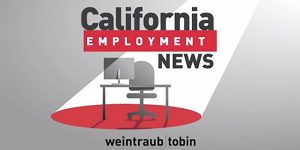 Employee personnel files are an important aspect of any employer’s records. Meagan Bainbridge and Nikki Mahmoudi review the basics of employee personnel files, including what should and should not be included and handling inspection requests, in this featured episode of California Employment News.
Employee personnel files are an important aspect of any employer’s records. Meagan Bainbridge and Nikki Mahmoudi review the basics of employee personnel files, including what should and should not be included and handling inspection requests, in this featured episode of California Employment News.
Watch this episode on the Weintraub YouTube channel and listen to this podcast episode here.
Show Notes:
Meagan
Hello, everyone. Thank you for joining us for this installment of “California Employment News”, an informative video and podcast resource offered by the labor and employment group at Weintraub Tobin. My name is Meagan Bainbridge, and I’m a shareholder in the firm’s labor and employment group. Today I’m joined by my colleague Nikki Mahmoudi, and we will be discussing personnel files and more importantly, what should and should not be included in an employee’s personnel file. Nikki, why don’t you start off with describing what labor codes section 1198.5 tells us about personnel files?
Nikki
Of course. So, the labor code section provides that current and former employees or a representative have the right to inspect and receive a copy of the personnel filing records relating to the employee’s performance or to any grievance concerning the employee. Now, the key here is it has to be a written request. So categories of records that are generally considered to be personnel records, they’re typically those that are used or have been used to determine an employee’s qualifications for promotion, additional compensation, disciplinary action, including termination. So some examples of these records include hiring records, payroll authorization forms, notices, accommodation warning, discipline, termination, notices of layoff, leave of absence and vacation, notices of wage attachment or garnishment, education and training notices and records, performance appraisals or reviews, and attendance records. Now, there’s some records that the right to inspect personnel records and files does not apply to. So these are records relating to the investigation of a possible criminal offense, letters of reference or ratings, reports or records that were one obtained prior to the employee’s employment, two were prepared by identifiable examination committee member or three obtained in connection with a promotional exam. Megan, are there any other tips that you have for the process of providing these records or copying these records?
Meagan
Thanks, Nikki. Well, the code provides that employers should maintain a copy of personnel records for a period of three years after termination. Per new legislation in 2022, employers should now maintain a copy of personnel records for a period of no less than four years from the date of termination of an employee or a nonhier of an applicant, and possibly even longer where employees or applicants have filed some sort of complaint alleging wrongdoing of some kind. If there is such a complaint, best practice would be to just maintain their personal record till the conclusion of that action. Employers should also remember that they must make their records available for inspections to both employees and former employees. These inspections must be allowed at a reasonable time and at a reasonable interview, but in most cases, no later than 30 calendar days from the date an employee makes the written request. Additionally, if requested by the employee or the employee’s representative, the inspection must be permitted at a place where the employee reports to work or at another location agreeable to the parties. Former employees, however, may inspect their records at the location where the employee stores those records, unless the parties agree to a different place in writing.
Copies of personnel records may also be provided by mail at the employee’s cost. Finally, while an employer is not required to make an employee’s personnel file available during the employee’s regular working hours, no loss of compensation to the employee should be permitted under any circumstances. Nikki, are there any limits to how often an employer has to comply with these kinds of requests?
Nikki
Yes, there are. So when it comes to former employees, an employer is required to comply with only one request per year. When it comes to representatives of the employees, an employer is not required to comply with more than 50 requests to inspect or receive a copy of personnel files filed by representative or representative employees in one calendar month. When it comes to current employees, we talk about how these inspections can happen within a reasonable interval, and typically that would be once every year. But there are some exceptions to this. Let’s say if there’s reasonable cause to believe that the file has been altered in a manner that might adversely affect the interest of the employee, or the file contains information pertinent to an ongoing investigation affecting the employee. One other thing to keep in mind is it is very important that employers comply with these requests. If an employer fails to either allow for the inspection or provide copies of these records with the times specified or times agreed to by mutual agreement, then employee or the labor commissioner may recover a penalty of $750 from the employer. Another thing that can happen is employees could also bring in action for injunctive relief to obtain compliance and potentially recover costs and reasonable attorney fees, which we want to avoid.
Meagan
Thanks, Nikki. And that does it for today. Thank you for joining us. You can continue to find the “California Employment News” on our blog at the www.lelawblog.com or wherever you listen to your favorite podcast. We’ll see you next time.
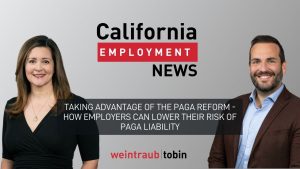 In this episode of California Employment News, Meagan Bainbridge and Ryan Abernethy break down the latest PAGA reforms and what employers need to know to reduce penalties and stay compliant. From new cure opportunities to proactive audits, they cover actionable steps to protect your business.
In this episode of California Employment News, Meagan Bainbridge and Ryan Abernethy break down the latest PAGA reforms and what employers need to know to reduce penalties and stay compliant. From new cure opportunities to proactive audits, they cover actionable steps to protect your business.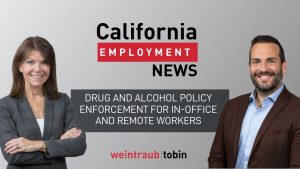 Recent legal developments have impacted drug and alcohol policy enforcement in the workplace. In this episode of California Employment News, Weintraub Labor & Employment attorneys
Recent legal developments have impacted drug and alcohol policy enforcement in the workplace. In this episode of California Employment News, Weintraub Labor & Employment attorneys  California expands employee rights for victims of violence: new leave policies and protections under AB 2499 take effect Jan 1. Weintraub attorneys
California expands employee rights for victims of violence: new leave policies and protections under AB 2499 take effect Jan 1. Weintraub attorneys 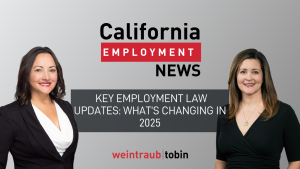 New changes to employment law are coming in 2025! Weintraub Labor and Employment attorneys
New changes to employment law are coming in 2025! Weintraub Labor and Employment attorneys  Big changes for CA healthcare workers! New minimum wage rates are in effect, with increases rolling out as of October 16, 2024. Weintraub attorneys
Big changes for CA healthcare workers! New minimum wage rates are in effect, with increases rolling out as of October 16, 2024. Weintraub attorneys  Another year is drawing closer, and with it comes another minimum wage increase for California.
Another year is drawing closer, and with it comes another minimum wage increase for California. 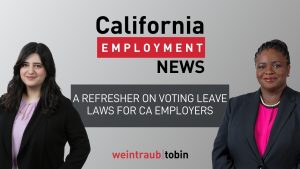 It is election season, and that means employees might need to take time off work to vote.
It is election season, and that means employees might need to take time off work to vote. 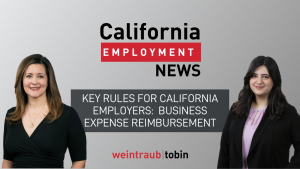 Are you reimbursing employees for business expenses? Weintraub attorneys
Are you reimbursing employees for business expenses? Weintraub attorneys 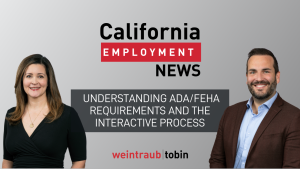 Meagan Bainbridge
Meagan Bainbridge Employee personnel files are an important aspect of any employer’s records.
Employee personnel files are an important aspect of any employer’s records.